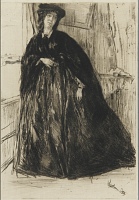Etchings Institutions search term: grolier club
Finette | ||
| Number: | 61 | |
| Date: | 1859 | |
| Medium: | etching and drypoint | |
| Size: | 293 x 202 mm | |
| Signed: | 'Whistler.' at lower right (3); replaced with new 'Whistler.' at lower right (4-final) | |
| Inscribed: | '1859 -' at lower right (3); replaced with new '1859.' at lower right (4-final) | |
| Set/Publication: | 'Cancelled Plates', 1879 | |
| No. of States: | 14 | |
| Known impressions: | 38 | |
| Catalogues: | K.58; M.58; T.56; W.54 | |
| Impressions taken from this plate (38) | ||
KEYWORD
TITLE
'Finette' (1870s, Whistler). 2
'Finette' (1874, Ralph Thomas, Jr (1840-1876)). 3
'Finette – with a View of Paris from the Window' (1874, James Anderson Rose (1819-1890)). 4
'Finette' (1886, Frederick Wedmore (1844-1921)). 5
'Finette' (1887/1888, Whistler). 6
Whistler called this portrait by the model's stage name, 'Finette'. All published catalogues followed Whistler's example.
3: Thomas 1874 (cat. no. 56).
4: Liverpool 1874 (cat. no. 529).
5: Wedmore 1886 A (cat. no. 54).
6: List, [August 1887/1888], GUW #13233.
DESCRIPTION
SITTER
7: List, [1890/1892], GUW #12715.
8: Thomas 1874 (cat. no. 56); Wedmore 1886 A (cat. no. 54); Mansfield 1909 (cat. no 58).
9: ibid.
10: Thomas 1874 (cat. no. 56); Mansfield 1909 (cat. no 58).
SITE
11: Thomas 1874 (cat. no. 56).
12: Wedmore 1886 A (cat. no. 54).
DISCUSSION

Wenceslaus Hollar, The large study of muffs and other finery
British Museum, 1868,0822.545
©Trustees of the British Museum.
The pile of letters, box, mask, feather fan, etcetera, on Finette's table are almost certainly also influenced by the elaborate still-life etchings of Wenceslaus Hollar, such as The large study of muffs and other finery, of 1647, reproduced above. 14
The silk 'domino' worn over Finette's dress, as well as the discarded mask, show that Finette had been at the Paris Carnival. The cigarette in her hand and smart bonnet help locate her in a fashionable milieu in contemporary Paris, where she was a well-known actress and dancer. 15
Wedmore described her as 'In the days of gigantic crinoline, a plain woman, in a black velvet dress,' and concerning his third state added, 'On the table lie, clearly defined, a mask, a fan, and an open box. I add, on Mr. Thibaudeau's authority, that the box contains billets doux.' 16 To this Cosmo Monkhouse objected that posterity had no interest in such opinions. 17
13: Lochnan 1984 , pp.107-11.
14: R. Pennington, A descriptive catalogue of the etched work of Wenceslaus Hollar, Cambridge, 1982; F. W. H. Hollstein, The New Hollstein: German engravings, etchings and woodcuts 1400-1700, Amsterdam, 1996.
15: MacDonald 2003 , pp. 55-58.
16: Wedmore 1886 A (cat. no. 54).
17: 'Whistler's Etchings: a Study and a catalogue by Frederick Wedmore (Thibaudeau)', The Academy, 10 February 1887, p. 136.
18: Lochnan 1984 , pp. 107-11.
19: ibid.



